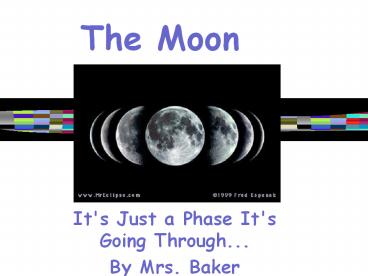The Moon PowerPoint PPT Presentation
Title: The Moon
1
The Moon
- It's Just a Phase It's Going Through...
- By Mrs. Baker
2
Moon
- Our planet's large natural satellite, the Moon,
is the easiest astronomical object to observe. - The only "scientific instrument" you'll need at
first is a pair of eyes.
Picture from NASA
3
The Moon's Orbit
- Rotation
- Moon is spinning on its axis
- Revolution
- The moon orbits around the Earth
- It takes the moon approximately one month to go
around the Earth.
4
Why do we never see the DARK SIDE?
- Synchronous Rotation is the reason we never see
the dark side of the moon. - Over the millennia, the Moon has become "locked"
into a special kind of motion around the Earth. - It rotates on its axis at the same pace as it
revolves around the Earth - As a result, the Moon keeps the same face toward
us throughout its orbit.
5
Phases
- The lighted side of the moon always faces
- the sun.
6
New Moon
What we see
- New moon occurs when the moon is between the sun
the Earth. - The dark side of the moon is facing the Earth.
What is happening from above.
Sunlight
7
Full Moon
What we see
- The full moon occurs when the Moon the Sun are
on opposite sides of the Earth. - The lighted side of the moon is facing Earth.
What is happening from above.
Sunlight
8
Full Moon
- The full moon is given different names, depending
on when it appears. For example, the "Harvest
moon" is the full moon that appears nearest to
the Autumnal Equinox, occurring in late September
or early October. Some other full moon names (by
month) include - January Moon After Yule, Wolf Moon, or Old Moon
- February Snow Moon or Hunger Moon
- March Sap Moon, Crow Moon, or Lenten Moon
- April Grass Moon or Egg Moon
- May Milk Moon or Planting Moon
- June Rose Moon, Flower Moon, or Strawberry Moon
- July Thunder Moon or Hay Moon
- August Grain Moon or Green Corn Moon
- September Fruit Moon or Harvest Moon
- October Harvest Moon or Hunter's Moon
- November Hunter's Moon or Frosty Moon,
- December Moon Before Yule or Long Night Moon.
9
Blue Moon
- When there is more than one full moon in a month,
the second moon is called a blue moon. - A blue moon happens every two years on average.
- The phrase, Once in a blue moon means very
rarely or very seldom or almost never.
10
First QuarterMoon
What we see
- The First quarter moon occurs when the moon is
halfway between new and full. - As seen from the Earth, half the moons disk is
illuminated.
What is happening from above.
Sunlight
11
Third QuarterMoon
What we see
- The Third or last quarter moon occurs halfway
between the full moon the new moon. - As seen from the Earth, half the moons disk is
illuminated.
What is happening from above.
Sunlight
12
Waxing
- When the moon is between new full, the visible
part of the moon is increasing. - This is called waxing
Sunlight
13
Waning
- When the moon is between full new, the visible
part of the moon is decreasing. - This is called waning.
Sunlight
14
Crescent Moon
Full Moon
- When the moon is between New 1st Quarter it is
called a waxing crescent.
1st Quarter
3rd Quarter
Waning Crescent
- When the moon is between 3rd New it is called
a waning crescent.
Waxing Crescent
New Moon
Sunlight
15
Gibbous Moon
Full Moon
Waning Gibbous
- When the moon is between 1st Quarter Full it is
called a waxing gibbous.
Waning Gibbous
1st Quarter
3rd Quarter
- When the moon is between Full 3rd it is called
a waning gibbous.
Waning Crescent
Waxing Crescent
New Moon
Sunlight
16
Moon Movie

